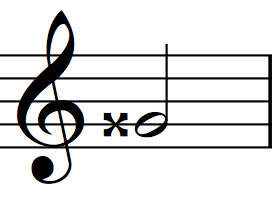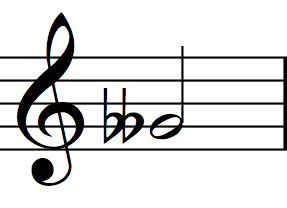21 More Enharmonics
INTRODUCTION
In this unit you will learn more about enharmonics.
NOTATIONS
More About Enharmonics
As you learned in Unit 10, enharmonics are notes that create the same pitch despite being notated differently. In other words, the notes are spelled differently but sound the same. You already know that every sharp note has a flat enharmonic. For example, ‘F-sharp‘ and ‘G-flat‘ are enharmonics. The enharmonics introduced in this chapter not nearly as common as the ones you already know. However, they do appear from time to time, which is why you need to understand two new symbols: the double sharp and the double flat.
Double Sharp

The double sharp looks like an ‘x.’
Double Flat

The double flat consists of two flat symbols.
Rules For Enharmonics
- Sharp means one fret higher in pitch.
- For example, ‘E-sharp’ is one fret higher than ‘E.’ The note ‘F’ is also one fret higher than ‘E.’ Therefore, ‘E-sharp’ and ‘F’ are enharmonics.
- Flat means one fret lower in pitch.
- For example, ‘C-flat’ is one fret lower than ‘C’. The note ‘B ‘ is also one fret lower than ‘C.’ Therefore, ‘C-flat’ and ‘B ‘ are enharmonics.
- Double sharp means two frets higher in pitch.
- For example, ‘D-double sharp’ is two frets higher than ‘D.’ Therefore, ‘D-double sharp’ and ‘E ‘ are enharmonics.
- Double flat means two frets lower in pitch.
- For example, ‘G-double flat ‘ is two frets lower than ‘G.’ Therefore, ‘G-double flat‘ and ‘F ‘ are enharmonics.
Double sharps and double flats may seem unnecessarily bizarre. However, music theory presents logical reasons for their usage in music notation. If you are interested understand why, and in what circumstances, double sharps and double flats are used, please view this video.
Comparison of Enharmonics
Each measure below contains notes that are enharmonics. In the first measure, ‘G-double sharp ‘ is the same as ‘A’, which is the same as ‘B-double flat.’ Despite the different spellings, all three of these notes can be played on the second fret of the third string.
Let’s Play |
Sight-Reading Tip
The study of music is a life-long adventure. You will most likely embark on a new musical endeavor upon completion of this series. But before you do, take a moment to reflect on your accomplishment. What has sight-reading developed in you? In what ways have you grown, not just musically, but in other aspects of your life as well? Take a moment to celebrate these new gifts! Well done!
Checklist for Sight-Reading
- Count the beats out loud (including the &).
- Keep going (even if you make a mistake).
- Maintain your best playing posture.
- Look at the score, not your hands.
- Play with the feel of the meter.
- Play patterns instead of individual notes (AKA chunk).
- Cultivate a calm demeanor.
- Have fun! (format: paragraph and bullet points)
Let’s Play Rhythms |
Attitude Tip
The present changes the past. Looking back you do not find what you left behind. —Kiran Desai
Exercise 21.1: Score
Exercise 21.1: Audio
Exercise 21.2: Score
Exercise 21.2: Audio
Let’s Play Patterns |
Attitude Tip
One thorn of experience is worth a whole wilderness of warning. —James Russell Lowell
Exercise 21.3: Score
Exercise 21.3: Audio
Exercise 21.4: Score
Exercise 21.4: Audio
Let’s Play Duets |
Attitude Tip
When you do something you should burn yourself completely, like a good bonfire, leaving no trace of yourself. —Shunryu Suzuki
Exercise 21.5: Audio (TBA)
Exercise 21.6: Audio (TBA)
Exercise 21.7: Audio (TBA)
Let’s Play Compositions |
These compositions are under the Creative Commons Attribution-NonCommercial 4.0 International License (CC BY-NC 4.0).
Attitude Tip
Let everything happen to you: beauty and terror. Just keep going. No feeling is final. —Rainer Maria Rilke
Pigeon Dream by Peter Yates: Score
Pigeon Dream: Audio
To play Process III according to the El Ansary’s intentions you must abide by the string number indications. In this piece the standard method (not the Norman method) applies, meaning circled Arabic numerals represent string numbers.
Process III, from The Art of Process by Bahaa El Ansary: Score
Process III, from The Art of Process: Audio
The next two pieces are at the level of advanced sight-reading. You may want to play each four times. First, clap the rhythms. Second, sight-read Guitar 1’s upper voice. Third, sight-read Guitar 1’s lower voice. And, finally, sight-read the entire Guitar 1 part.
Binary Repair by Felix Salazar & Eric Kiersnowski: Score
Binary Repair: Audio
Sdüuit by Felix Salazar & Eric Kiersnowski: Score
Sdüuit: Audio
Congratulations!
You have completed this unit! If you kept up with the beat and accurately played approximately 70% of the pitches and rhythms, you are ready for the next unit. Feel free to repeat the exercises. However, do not play them so often that you memorize them. Once you memorize the notation, you are no longer developing the skill of sight-reading.


